Dealing with red spots on bottom of feet can be quite annoying. They may itch a lot and even contain fluid. Many different skin conditions can cause this condition. While red spots are usually not very serious, they can sometimes be contagious and spread easily. Knowing the underlying cause of red dots on soles helps you find the best treatment option.
Causes and Treatment for Red Dots on Bottom of Feet
1. Insect Bites
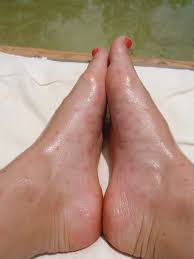
You may develop red spots when insects such as bed bugs and mosquitoes bite you. These red spots can be very itchy and sometimes swell because your body releases histamines in response to these bites.
Treatment:
You may find some relief by applying calamine lotion. These dots are usually not serious, but you should see your doctor in case malaria is common in your area, which spreads through mosquito bites.
2. Impetigo

Caused by bacteria, this contagious skin infection usually affects children and infants. You become affected when the bacteria enter your skin through cuts or insect bites. Impetigo reveals itself as red and fluid-filled sores that are quite painful. These sores may rupture and ooze as well. Then, yellow-brownish crusts develop that itch a lot.
Treatment:
Use antibiotic creams or ointments to treat impetigo. You can apply the cream directly on your red dots on bottom of feet. Soak your affected area in warm water first to remove the scabs and then apply the antibiotic ointment for better results. You might need to take oral antibiotic medications in case you have lots of impetigo sores. Always finish your course of medication even if you feel better after a few days, or else the infection will return and may become more resistant to antibiotics.
3. Dyshidrosis
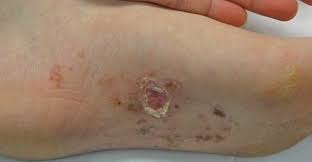
Also known as pompholyx or dyshidrotic eczema, dyshidrosis causes tiny fluid-filled blisters to appear on your palms as well as on soles of your feet. These spots itch a lot and the condition may persist for about 3 weeks.
Treatment:
Your doctor may give you corticosteroid ointments or creams to help treat your dyshidrosis. Apply the cream and cover the affected area with plastic wrap to improve absorption. You can also apply moist compresses after applying the corticosteroid ointment. Sometimes, you also need to take corticosteroid pills such as prednisone to treat your condition. Other treatment options include the following:
- Phototherapy: Your doctor may recommend light therapy in case other treatments do not produce desired results. The procedure involves exposing your affected area to UV light with drugs to make your skin more sensitive to the medication used.
- Immune-Suppressing Ointments: Sometimes, you have to take medications such as pimecrolimus or tacrolimus to suppress your immune system response. This may help treat dyshidrosis, but it increases your risk of other skin infections.
- Botulinum Toxin Injections: Sometimes, other treatments do not work in severe cases of dyshidrosis. In this condition, your doctor may recommend botulinum toxin injections to help treat your condition.
4. Rocky Mountain Spotted Fever
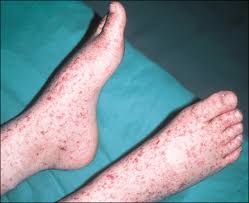
Transmitted by tick bites, this serious bacterial infection causes red spots to appear on your ankles, wrists and soles. You may also develop some other symptoms, such as nausea, severe headache, high fever, loss of appetite, vomiting, fatigue, and delirium.
Treatment:
Your doctor will remove the tick from your skin and then prescribe antibiotics to eliminate the infection. The most common antibiotics used in this case are tetracycline and doxycycline. You may have to take chloramphenicol if you are pregnant.
5. Hand-Foot-Mouth Disease
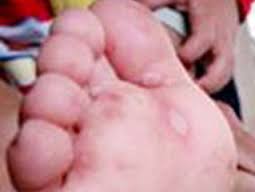
This contagious viral infection usually affects young children and leads to the development of sores in the mouth with red rash on soles, palms, and even on the buttocks. Caused mainly by the coxsackievirus, it may also produce other symptoms, including fever, loss of appetite, irritability in toddlers, sore throat, red blisters on the tongue and inside of the cheeks, and general feeling of being unwell.
Treatment:
Unfortunately, there is no treatment available for this viral infection. It may take up to 10 days for your symptoms to clear up completely. Nevertheless, you can use topical oral anesthetics to alleviate pain caused by mouth sores. OTC pain relievers such as acetaminophen or ibuprofen may also help make this condition more manageable.
6. Chickenpox
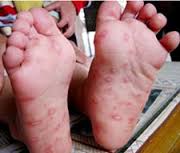
You may develop red dots on bottom of feet and on other parts of your body in case you have a viral infection called varicella or chickenpox. You usually develop fluid-filled blisters that itch a lot. It takes 10-21 days after the exposure to the virus to develop these spots and other symptoms. Chickenpox infection may last about 5-10 days. You may develop a rash on bottom of your feet, but other symptoms such as loss of appetite, fever, tiredness, and headache usually appear 1-2 days before the rash appears.
Treatment:
You do not require medical treatment for this skin condition. Sometimes, you have to take an antihistamine to control your itching. The disease usually has three main stages:
- During the first stage, you develop raised red or pink papules that break out over several days.
- During the second stage, those raised bumps turn into small fluid-filled blisters that eventually break and leak.
- During the third stage, crusts and scabs develop over your blisters that take several days to heal.
In some cases, you need to take an antiviral drugs such as acyclovir or immune globulin intravenous to reduce the severity of your condition. Take these medications within the first 24 hours of noticing the rash.
Note: So many issues can cause red dots on bottom of feet, therefore it is better to see your doctor instead of diagnosing by yourself.
